An Autonomous Home Energy Management System Using Dynamic Priority Strategy in Conventional Homes
Abstract
:1. Introduction
1.1. Related Works
1.2. Contribution of the Work
1.3. Organization of the Paper
2. Proposed Hardware for Smart Home
2.1. Smart Plugs Design
2.2. HEMS Controller
2.3. Transmission Unit
3. Energy Management Strategy
3.1. Formulation of Electrical Appliances in Case of Energy Consumption
3.2. Pricing Formulation
3.3. Energy Management Algorithm
4. Case Study
Materials and Methods
5. Result and Discussion
6. Conclusions
Author Contributions
Funding
Acknowledgments
Conflicts of Interest
References
- Shakeri, M.; Shayestegan, M.; Reza, S.M.S.; Yahya, I.; Bais, B.; Akhtaruzzaman, M.; Sopian, K.; Amin, N. Implementation of a novel home energy management system (HEMS) architecture with solar photovoltaic system as supplementary source. Renew. Energy 2018, 125, 108–120. [Google Scholar] [CrossRef]
- Kakran, S.; Chanana, S. Optimal Energy Scheduling Method under Load Shaping Demand Response Program in a Home Energy Management System. Int. J. Emerg. Electr. Power Syst. 2019, 20. [Google Scholar] [CrossRef]
- Zhai, S.; Wang, Z.; Yan, X.; He, G. Appliance Flexibility Analysis Considering User Behavior in Home Energy Management System Using Smart Plugs. IEEE Trans. Ind. Electron. 2019, 66, 1391–1401. [Google Scholar] [CrossRef]
- Pawaskar, K.; Prajapati, P.; Shah, D. IoT Based Home Automation. In Vaishali, IoT Based Home Automation (October 29, 2018). Available online: https://ssrn.com/abstract=3274486 (accessed on 28 June 2020).
- Xu, L.D.; Xu, E.L.; Li, L. Industry 4.0: State of the art and future trends. Int. J. Prod. Res. 2018, 56, 2941–2962. [Google Scholar] [CrossRef] [Green Version]
- Zhou, B.; Li, W.; Chan, K.W.; Cao, Y.; Kuang, Y.; Liu, X.; Wang, X. Smart home energy management systems: Concept, configurations, and scheduling strategies. Renew. Sustain. Energy Rev. 2016, 61, 30–40. [Google Scholar] [CrossRef]
- Chen, M.; Yang, J.; Zhu, X.; Wang, X.; Liu, M.; Song, J. Smart home 2.0: Innovative smart home system powered by botanical IoT and emotion detection. Mob. Netw. Appl. 2017, 22, 1159–1169. [Google Scholar] [CrossRef]
- Al-Kuwari, M.; Ramadan, A.; Ismael, Y.; Al-Sughair, L.; Gastli, A.; Benammar, M. Smart-home automation using IoT-based sensing and monitoring platform. In Proceedings of the 2018 IEEE 12th International Conference on Compatibility, Power Electronics and Power Engineering (CPE-POWERENG 2018), Doha, Qatar, 10–12 April 2018; pp. 1–6. [Google Scholar]
- Son, S.C.; Kim, N.W.; Lee, B.T.; Cho, C.H.; Chong, J.W. A time synchronization technique for coap-based home automation systems. IEEE Trans. Consum. Electron. 2016, 62, 10–16. [Google Scholar] [CrossRef]
- Neupane, B.; Siksnys, L.; Pedersen, T.B. Generation and Evaluation of Flex-Offers from Flexible Electrical Devices. In Proceedings of the Eighth International Conference on Future Energy Systems, Hong Kong, China, 16–19 May 2017; pp. 143–156. [Google Scholar]
- Singh, H.; Pallagani, V.; Khandelwal, V.; Venkanna, U. IoT based smart home automation system using sensor node. In Proceedings of the 2018 4th International Conference on Recent Advances in Information Technology (RAIT), Dhanbad, India, 21 June 2018; pp. 1–5. [Google Scholar]
- Haider, H.T.; See, O.H.; Elmenreich, W. A review of residential demand response of smart grid. Renew. Sustain. Energy Rev. 2016, 59, 166–178. [Google Scholar] [CrossRef]
- Roy, T.; Das, A.; Ni, Z. Optimization in load scheduling of a residential community using dynamic pricing. In Proceedings of the 2017 IEEE Power & Energy Society Innovative Smart Grid Technologies Conference (ISGT), Washington, DC, USA, 30 October 2017; pp. 1–5. [Google Scholar]
- Javaid, S.; Abdullah, M.; Javaid, N.; Sultana, T.; Ahmed, J.; Sattar, N.A. Towards Buildings Energy Management: Using Seasonal Schedules Under Time of Use Pricing Tariff via Deep Neuro-Fuzzy Optimizer. In Proceedings of the 2019 15th International Wireless Communications & Mobile Computing Conference (IWCMC), Tangier, Morocco, 22 July 2019; pp. 1594–1599. [Google Scholar]
- Hanmin, S.; Kai, C.; Hongjun, K.; Linhai, Y.; Yuanyuan, L. An Incremental ELM Method for Hourly Load Forecasting. In Proceedings of the 2019 IEEE PES GTD Grand International Conference and Exposition Asia (GTD Asia), Bangkok, Thailand, 16 May 2019; pp. 183–187. [Google Scholar]
- Aurangzeb, K.; Aslam, S.; Haider, S.I.; Mohsin, S.M.; Islam, S.u.; Khattak, H.A.; Shah, S. Energy forecasting using multiheaded convolutional neural networks in efficient renewable energy resources equipped with energy storage system. Trans. Emerg. Telecommun. Technol. 2019, e3837. [Google Scholar] [CrossRef]
- Aslam, S.; Khalid, A.; Javaid, N. Towards efficient energy management in smart grids considering microgrids with day-ahead energy forecasting. Electr. Power Syst. Res. 2020, 182, 106232. [Google Scholar] [CrossRef]
- Yuce, B.; Rezgui, Y.; Mourshed, M. ANN–GA smart appliance scheduling for optimised energy management in the domestic sector. Energy Build. 2016, 111, 311–325. [Google Scholar] [CrossRef]
- Gharghan, S.K.; Nordin, R.; Ismail, M.; Ali, J.A. Accurate wireless sensor localization technique based on hybrid PSO-ANN algorithm for indoor and outdoor track cycling. IEEE Sens. J. 2015, 16, 529–541. [Google Scholar] [CrossRef]
- Rastegar, M.; Fotuhi-Firuzabad, M.; Zareipour, H. Home energy management incorporating operational priority of appliances. Int. J. Electr. Power Energy Syst. 2016, 74, 286–292. [Google Scholar] [CrossRef]
- Ratnam, E.L.; Weller, S.R.; Kellett, C.M. Scheduling residential battery storage with solar PV: Assessing the benefits of net metering. Appl. Energy 2015, 155, 881–891. [Google Scholar] [CrossRef]
- Missaoui, R.; Joumaa, H.; Ploix, S.; Bacha, S. Managing energy smart homes according to energy prices: Analysis of a building energy management system. Energy Build. 2014, 71, 155–167. [Google Scholar] [CrossRef]
- Huang, Y.; Tian, H.; Wang, L. Demand response for home energy management system. Int. J. Electr. Power Energy Syst. 2015, 73, 448–455. [Google Scholar] [CrossRef]
- Jain, A.K.; Srivastava, S. Price responsive demand management of an industrial buyer in day-ahead electricity market. Int. J. Emerg. Electr. Power Syst. 2017, 18. [Google Scholar] [CrossRef]
- Chen, Z.; Wu, L.; Fu, Y. Real-time price-based demand response management for residential appliances via stochastic optimization and robust optimization. IEEE Trans. Smart Grid 2012, 3, 1822–1831. [Google Scholar] [CrossRef]
- Rotger-Griful, S.; Jacobsen, R.H.; Nguyen, D.; Sørensen, G. Demand response potential of ventilation systems in residential buildings. Energy Build. 2016, 121, 1–10. [Google Scholar] [CrossRef]
- Rigodanzo, J.; da Rosa Abaide, A.; Garcia, V.J.; da Silva, L.N.F.; Hammerschmitt, B.K.; Bibiano, L.M. Residential Consumer Satisfaction Considering Tariff Variation Based on a Fuzzy Model. In Proceedings of the 2019 IEEE PES Innovative Smart Grid Technologies Conference-Latin America (ISGT Latin America), Gramado, Brazil, 11 November 2019; pp. 1–5. [Google Scholar]
- Shakeri, M.; Amin, N. Transformation of Conventional Houses to Smart Homes by Adopting Demand Response Program in Smart Grid. In Smart Microgrids; Nayeripour, M., Waffenschmidt, E., Kheshti, M., Eds.; IntechOpen: Rijeka, Croatia, 2018. [Google Scholar] [CrossRef] [Green Version]
- Poursharif, G.; Brint, A.; Holliday, J.; Black, M.; Marshall, M. Low voltage current estimation using AMI/smart meter data. Int. J. Electr. Power Energy Syst. 2018, 99, 290–298. [Google Scholar] [CrossRef]
- Andrey, C.; Haurie, A. The Economics of Electricity Dynamic Pricing and Demand Response Programmes. Technical Report. 2013. Available online: https://www.academia.edu/download/36626736/Report_1_-_updated.pdf (accessed on 28 June 2020).
- Zhu, T.; Mishra, A.; Irwin, D.; Sharma, N.; Shenoy, P.; Towsley, D. The case for efficient renewable energy management in smart homes. In Proceedings of the Third ACM Workshop on Embedded Sensing Systems for Energy-Efficiency in Buildings, Seattle, WA, USA, 1 November 2011; pp. 67–72. [Google Scholar]
- Thai, P.K.; Cândido, C.; Asumadu-Sakyi, A.; Barnett, A.; Morawska, L. Variation of indoor minimum mortality temperature in different cities: Evidence of local adaptations. Environ. Pollut. 2019, 246, 745–752. [Google Scholar] [CrossRef] [PubMed]
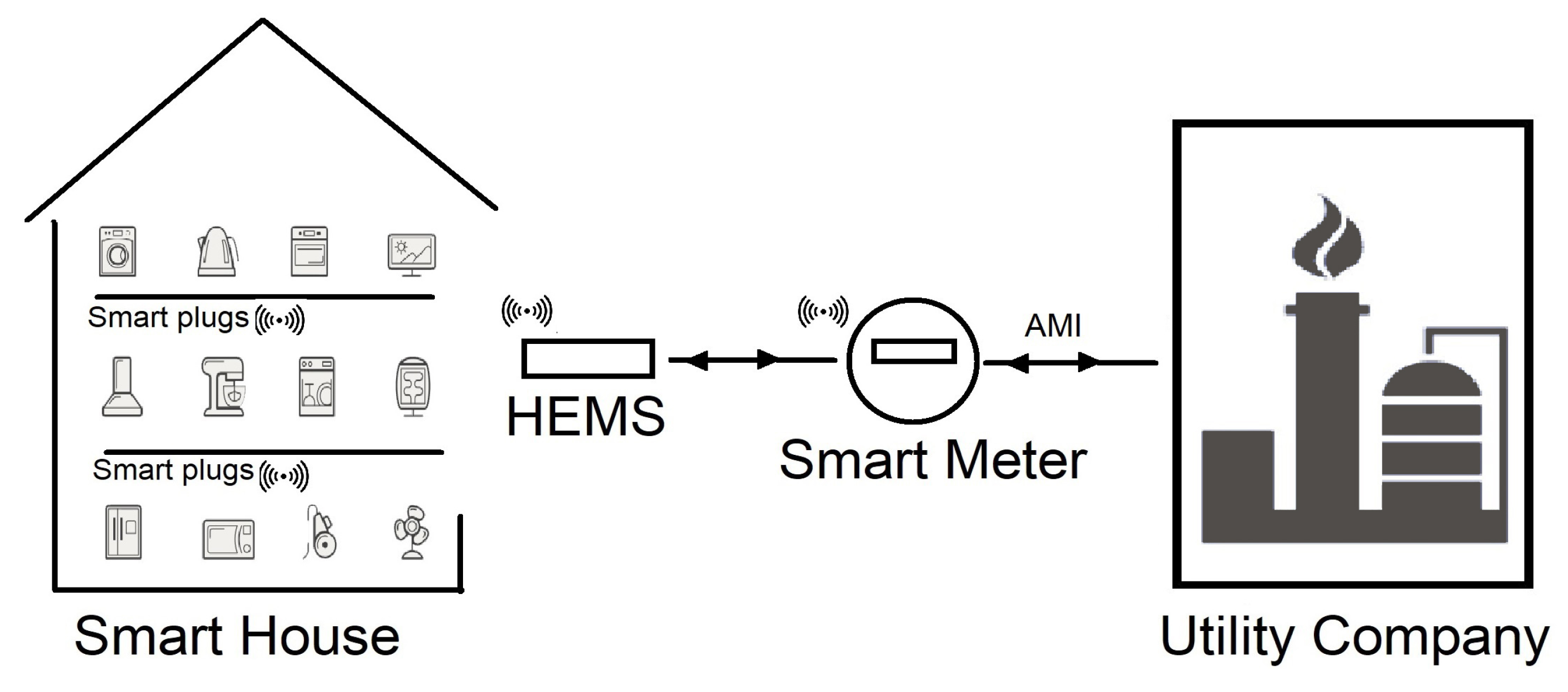
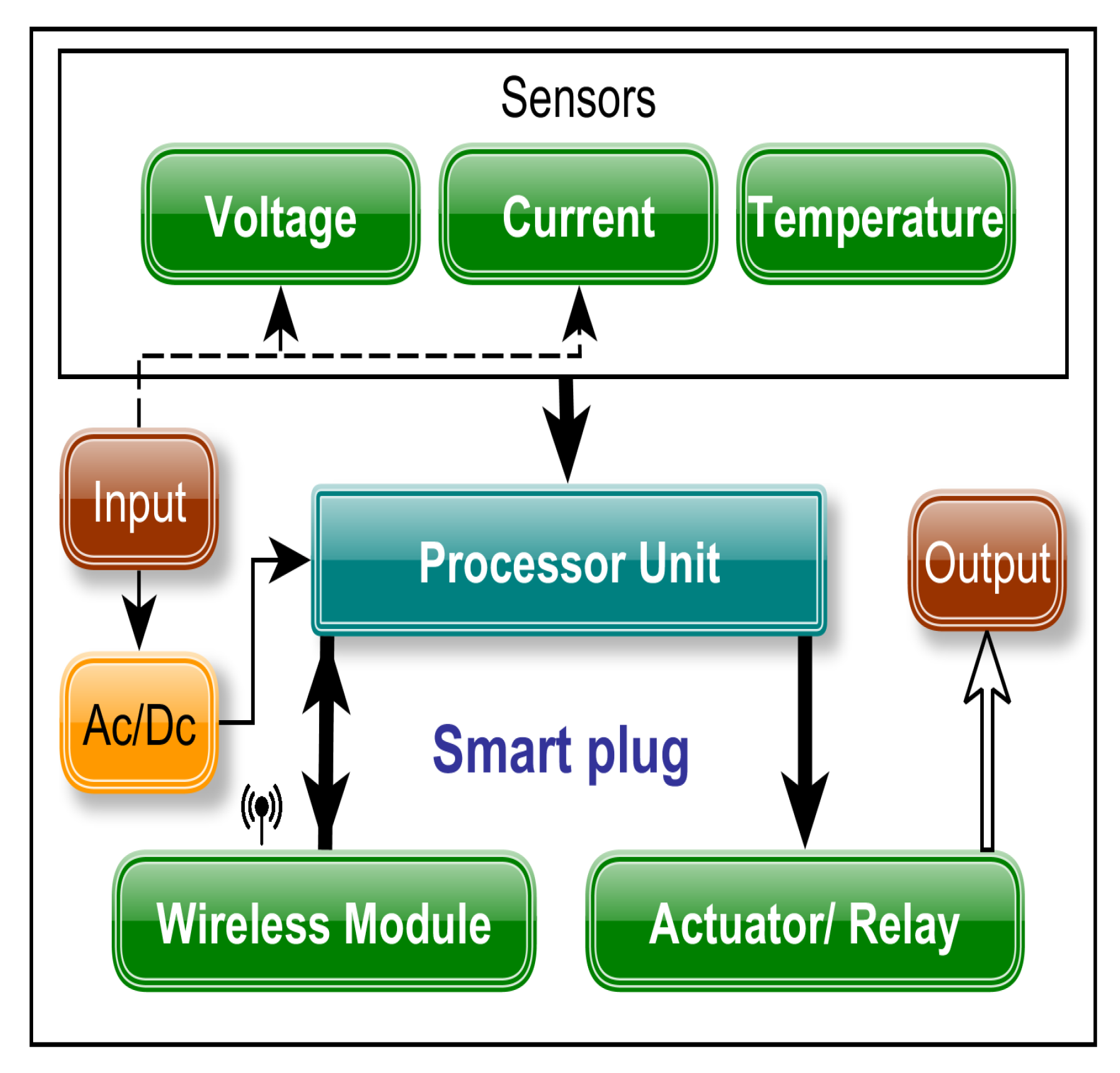
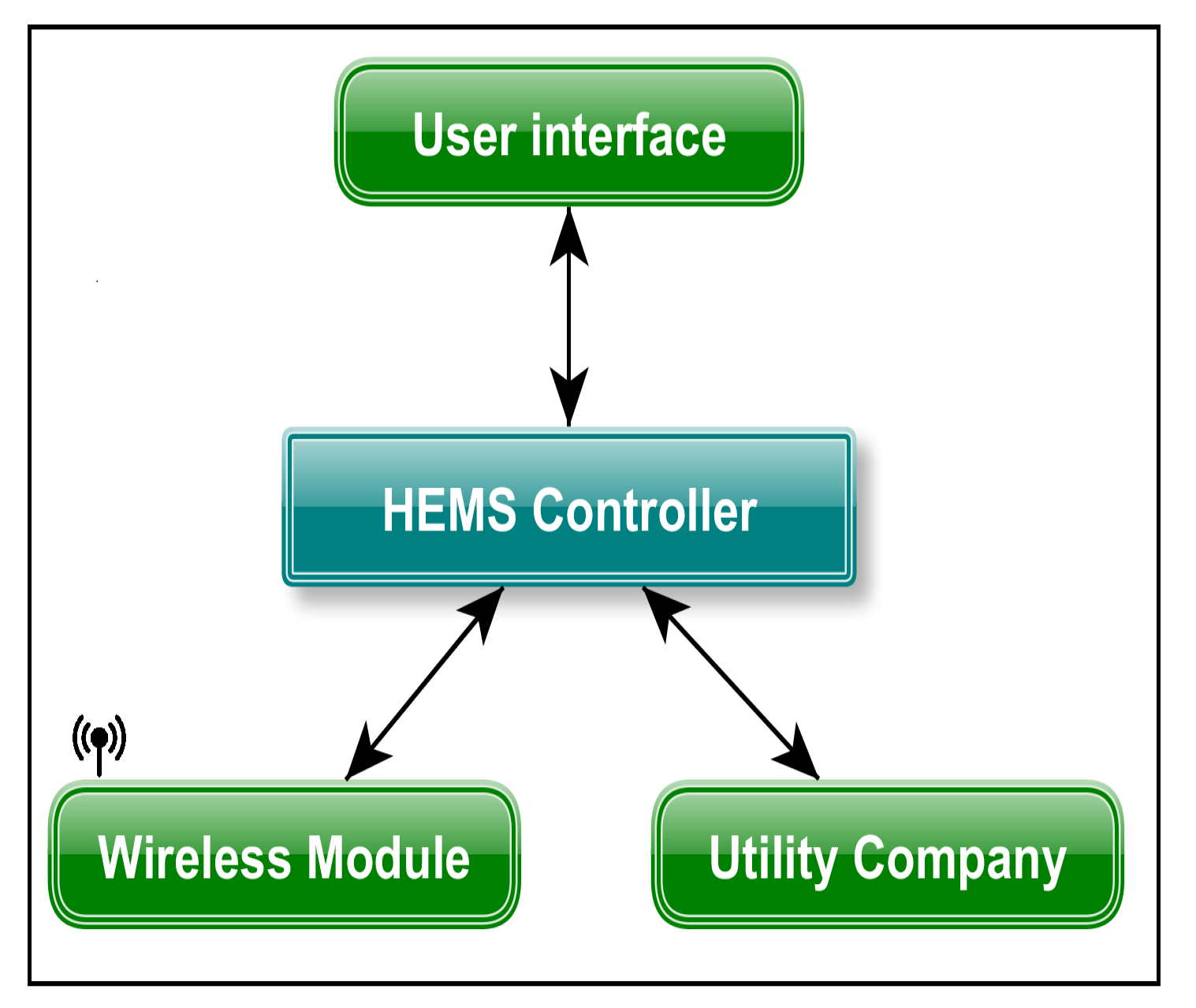

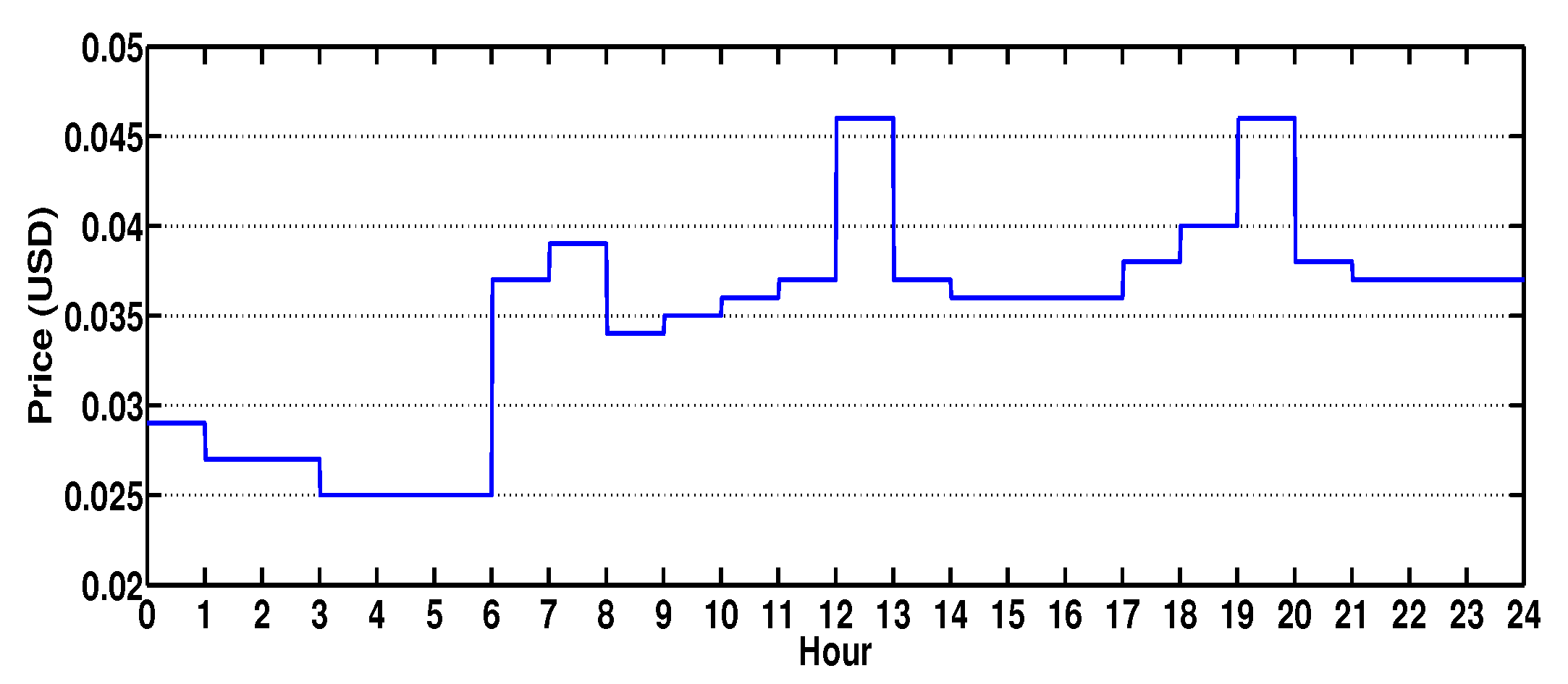
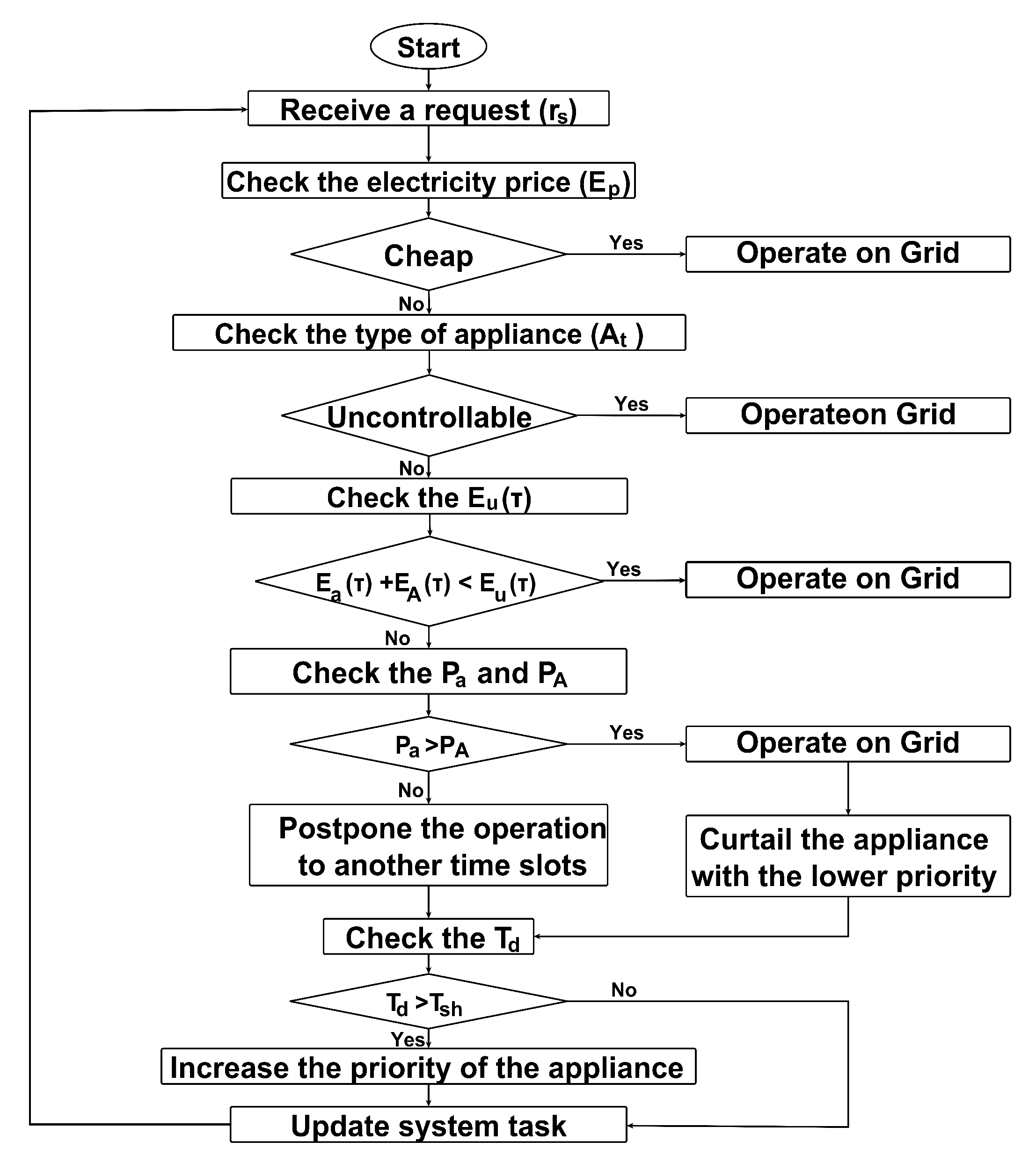
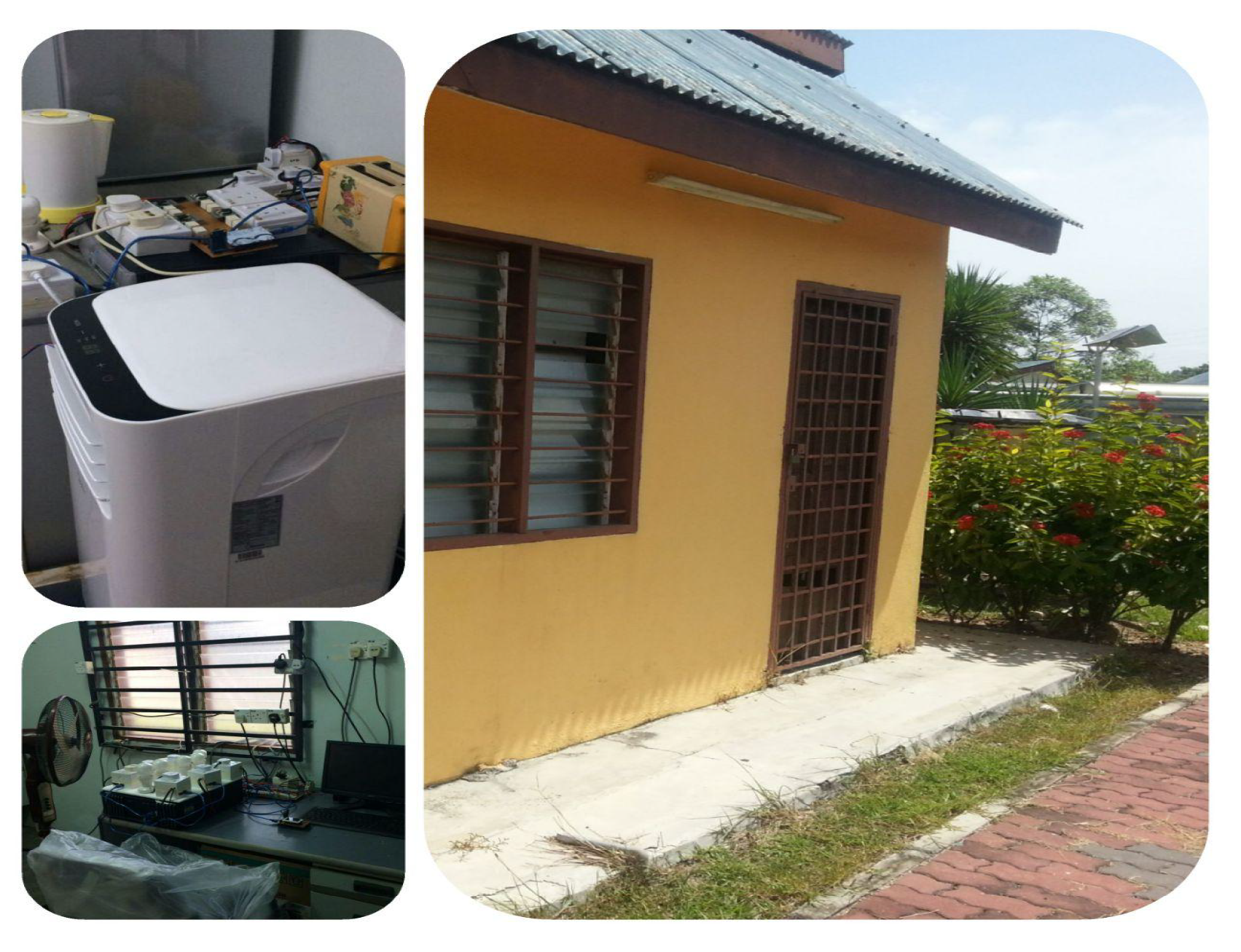






| Appliance | Rated-Power (W) | Priority | Number |
|---|---|---|---|
| controllable | |||
| Water heater | 1400 | 7 | 1 |
| Coffee maker | 1300 | 5 | 1 |
| Rice cooker | 1200 | 6 | 1 |
| Toaster | 800 | 4 | 1 |
| Air-conditioner | 1600 | 1 | 1 |
| Vacuum cleaner | 1500 | 3 | 1 |
| Hairdryer | 1000 | 8 | 1 |
| Washing machine | 350 | 2 | 1 |
| Iron | 1200 | 6 | 1 |
| Refrigerator | 250 | 1 | 1 |
| uncontrollable | |||
| Television | 150 | 9 | 1 |
| Fan | 80 | 9 | 1 |
| Lamps | 20–60 | 9 | 10 |
| Random loads | 20–80 | 9 | 4 |
© 2020 by the authors. Licensee MDPI, Basel, Switzerland. This article is an open access article distributed under the terms and conditions of the Creative Commons Attribution (CC BY) license (http://creativecommons.org/licenses/by/4.0/).
Share and Cite
Shakeri, M.; Amin, N.; Pasupuleti, J.; Mehbodniya, A.; Asim, N.; Tiong, S.K.; Low, F.W.; Yaw, C.T.; Samsudin, N.A.; Rokonuzzaman, M.; et al. An Autonomous Home Energy Management System Using Dynamic Priority Strategy in Conventional Homes. Energies 2020, 13, 3312. https://doi.org/10.3390/en13133312
Shakeri M, Amin N, Pasupuleti J, Mehbodniya A, Asim N, Tiong SK, Low FW, Yaw CT, Samsudin NA, Rokonuzzaman M, et al. An Autonomous Home Energy Management System Using Dynamic Priority Strategy in Conventional Homes. Energies. 2020; 13(13):3312. https://doi.org/10.3390/en13133312
Chicago/Turabian StyleShakeri, Mohammad, Nowshad Amin, Jagadeesh Pasupuleti, Abolfazl Mehbodniya, Nilofar Asim, Sieh Kiong Tiong, Foo Wah Low, Chong Tak Yaw, Nurul Asma Samsudin, Md Rokonuzzaman, and et al. 2020. "An Autonomous Home Energy Management System Using Dynamic Priority Strategy in Conventional Homes" Energies 13, no. 13: 3312. https://doi.org/10.3390/en13133312
APA StyleShakeri, M., Amin, N., Pasupuleti, J., Mehbodniya, A., Asim, N., Tiong, S. K., Low, F. W., Yaw, C. T., Samsudin, N. A., Rokonuzzaman, M., Hen, C. K., & Lai, C. W. (2020). An Autonomous Home Energy Management System Using Dynamic Priority Strategy in Conventional Homes. Energies, 13(13), 3312. https://doi.org/10.3390/en13133312










